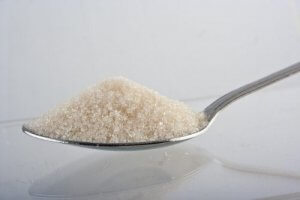Ketosis in Children: Causes and Treatment

When glucose levels suddenly go down, it can cause something called ketosis in children. This is especially likely to happen during their first stage of growth when energy consumption is highest.
Ketosis in children is a rare condition that small children can have, but which tends to decrease after four years of age. The presence of acetone in the infant’s body is a type of natural defense that springs into action when it has lost a large amount of glucose.
This is a volatile compound which, when it comes into contact with the air, reacts and gives off a characteristic smell very similar to that of an acidic apple.
Glucose in a child’s body
A child’s body needs three times more glucose than an adult’s does, and their reserves often run out quickly. That’s why acetone springs into action when their glucose supply has run out.
Acetone is one of the smallest ketones, and these components act in the absence of sugar and provide food for the body.
The human body is perfectly designed to activate defense mechanisms when it detects any deficiency. Ketosis in children occurs when the body looks for ways to avoid complications due to hypoglycemia.
Also called infant acetone, this defense mechanism is recognized by the characteristic smell in their breath and in their urine. To measure the presence of ketones, special urinary strips are used. You impregnate these with drops of urine and they’ll show whether ketones are there by changing color.

The child with ketosis usually has pharyngitis, mild diarrhea and even infections in the intestine that cause stomach aches, headache, loss of appetite, drowsiness, the presence of dark circles around the eyes, a dry mouth, among others.
Causes of ketosis in children
There are many factors that cause this defense mechanism to activate in a child’s body. Here are some of them:
An unbalanced diet
The deficiency may be due to being low in proteins, carbohydrates, saturated fats or fruit. That’s why it’s important to provide children with the right amount from each food group in their diet. You should ideally consult a nutritionist or pediatrician to establish the best diet for your child.
A long period without eating
When the child has spent more than twelve hours without eating, then the body will require more energy, and the body’s consumption of glucose increases. If acetone is present in the morning urine, it isn’t a cause for alarm, as the child has fasted while sleeping.
Becoming feverish
Certain infectious diseases usually show themselves through high temperatures and cause glucose to burn faster in order to obtain energy. Usually, in this type of illness, the little ones lose their appetite, so that their sugar levels reduce and ketosis is activated.
Propensity to vomit
This type of reaction causes a reduction in the body’s glucose stores. The presence of acetone can induce vomiting.
Treatment for ketosis in children
When this type of substance is detected in a child’s body, first of all, you need to put some very simple things into practice. Of course, you should always visit a specialist and follow the prescribed treatment to avoid possible complications.
In about three or four days you can control this defense mechanism without any problems. At home you could start with:
A balanced diet
Unquestionably, food plays a fundamental role in your child’s health, and it’s no exception in this case either. Simply maintain a daily balanced diet to reduce the presence of acetone in the body. Don’t eat processed food, but include food from all the nutrient groups.

Tea infusions
Tea, in all its different forms, brings many benefits to our bodies. You can offer the child an infusion of chamomile in small sips to help reduce the urge to vomit when this is the cause of the rise in acetone levels.
If the acetone levels in the body don’t go down after 24 hours after following a doctor’s instructions, then it would be wise to visit the pediatrician again to rule out any other condition, such as hyperthyroidism or type I diabetes.
We shouldn’t be too alarmed by the presence of acetone in our child’s body, but neither should we overlook its presence. Remember that prevention is always better than cure. In the case of ketosis in children, it’s very easy to avoid it just by getting your little one to eat a balanced diet.
When glucose levels suddenly go down, it can cause something called ketosis in children. This is especially likely to happen during their first stage of growth when energy consumption is highest.
Ketosis in children is a rare condition that small children can have, but which tends to decrease after four years of age. The presence of acetone in the infant’s body is a type of natural defense that springs into action when it has lost a large amount of glucose.
This is a volatile compound which, when it comes into contact with the air, reacts and gives off a characteristic smell very similar to that of an acidic apple.
Glucose in a child’s body
A child’s body needs three times more glucose than an adult’s does, and their reserves often run out quickly. That’s why acetone springs into action when their glucose supply has run out.
Acetone is one of the smallest ketones, and these components act in the absence of sugar and provide food for the body.
The human body is perfectly designed to activate defense mechanisms when it detects any deficiency. Ketosis in children occurs when the body looks for ways to avoid complications due to hypoglycemia.
Also called infant acetone, this defense mechanism is recognized by the characteristic smell in their breath and in their urine. To measure the presence of ketones, special urinary strips are used. You impregnate these with drops of urine and they’ll show whether ketones are there by changing color.

The child with ketosis usually has pharyngitis, mild diarrhea and even infections in the intestine that cause stomach aches, headache, loss of appetite, drowsiness, the presence of dark circles around the eyes, a dry mouth, among others.
Causes of ketosis in children
There are many factors that cause this defense mechanism to activate in a child’s body. Here are some of them:
An unbalanced diet
The deficiency may be due to being low in proteins, carbohydrates, saturated fats or fruit. That’s why it’s important to provide children with the right amount from each food group in their diet. You should ideally consult a nutritionist or pediatrician to establish the best diet for your child.
A long period without eating
When the child has spent more than twelve hours without eating, then the body will require more energy, and the body’s consumption of glucose increases. If acetone is present in the morning urine, it isn’t a cause for alarm, as the child has fasted while sleeping.
Becoming feverish
Certain infectious diseases usually show themselves through high temperatures and cause glucose to burn faster in order to obtain energy. Usually, in this type of illness, the little ones lose their appetite, so that their sugar levels reduce and ketosis is activated.
Propensity to vomit
This type of reaction causes a reduction in the body’s glucose stores. The presence of acetone can induce vomiting.
Treatment for ketosis in children
When this type of substance is detected in a child’s body, first of all, you need to put some very simple things into practice. Of course, you should always visit a specialist and follow the prescribed treatment to avoid possible complications.
In about three or four days you can control this defense mechanism without any problems. At home you could start with:
A balanced diet
Unquestionably, food plays a fundamental role in your child’s health, and it’s no exception in this case either. Simply maintain a daily balanced diet to reduce the presence of acetone in the body. Don’t eat processed food, but include food from all the nutrient groups.

Tea infusions
Tea, in all its different forms, brings many benefits to our bodies. You can offer the child an infusion of chamomile in small sips to help reduce the urge to vomit when this is the cause of the rise in acetone levels.
If the acetone levels in the body don’t go down after 24 hours after following a doctor’s instructions, then it would be wise to visit the pediatrician again to rule out any other condition, such as hyperthyroidism or type I diabetes.
We shouldn’t be too alarmed by the presence of acetone in our child’s body, but neither should we overlook its presence. Remember that prevention is always better than cure. In the case of ketosis in children, it’s very easy to avoid it just by getting your little one to eat a balanced diet.
All cited sources were thoroughly reviewed by our team to ensure their quality, reliability, currency, and validity. The bibliography of this article was considered reliable and of academic or scientific accuracy.
- Juguetes educativos – Akros. (2018). Qué es la cetosis en niños: Causas y soluciones. [online] Disponible en: https://akroseducational.es/blog/acetona-en-ninos/
- Autónomos, S. (2018). Acetona: un marcador de riesgo. Sanitas. https://www.sanitas.es/sanitas/seguros/es/particulares/biblioteca-de-salud/dieta-alimentacion/bioestilo-nutricion/acetona-marcador.html
This text is provided for informational purposes only and does not replace consultation with a professional. If in doubt, consult your specialist.








